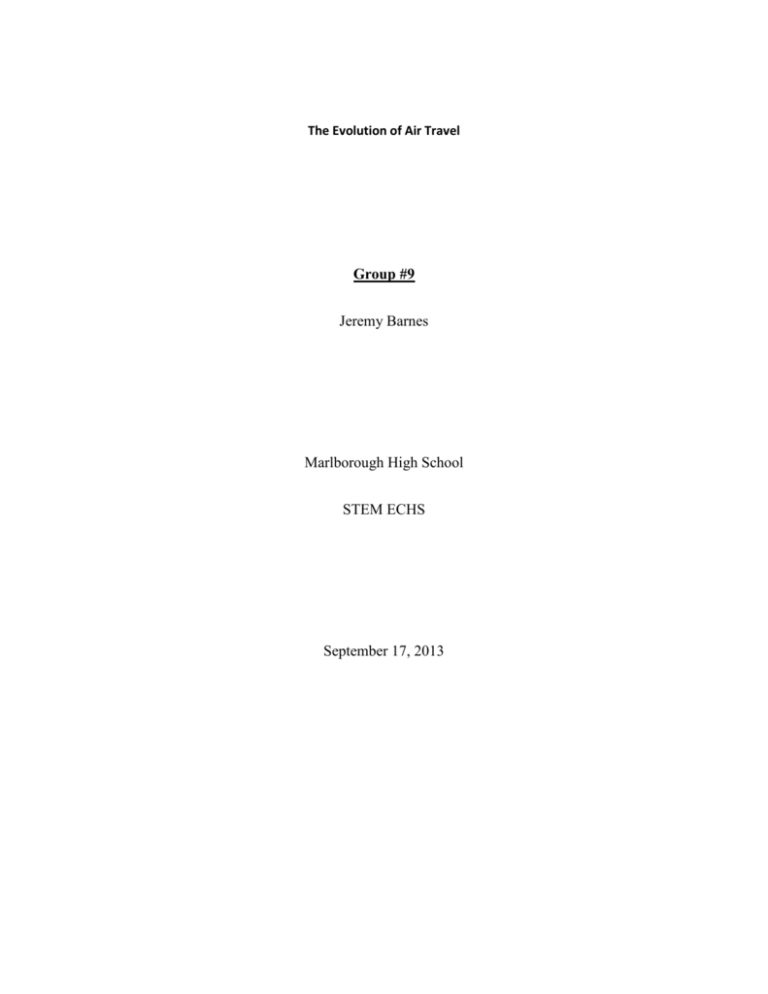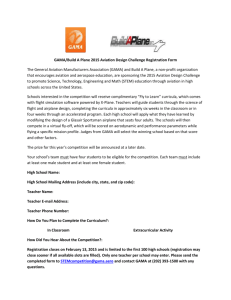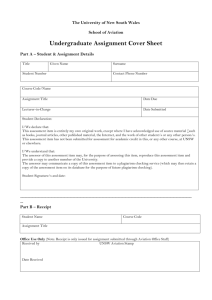File - Jeremy Barnes
advertisement

The Evolution of Air Travel Group #9 Jeremy Barnes Marlborough High School STEM ECHS September 17, 2013 Barnes 2 Air transportation vehicles have been around for over 100 years now. For over a century, new models of planes have been designed and they improve every time. Safety and cost efficiency are two major aspects in air travel. On December 17, 1903, Wilbur and Orville Wright designed and flew a 120 foot plane that successfully traveled in the air for 12 seconds in Kitty Hawk, North Carolina. After this very important event, many others designed different types of planes that could reach speeds of 130 miles per hour. The 1st scheduled air service started in Florida on the date of January 1st, 1914. In the year of 1917, Congress appropriated $100,000 for experimental air service which was mostly successful. The purpose of the $100,000 was so engineers could experiment with different types of aircraft designs. By the middle of the 1920’s, the Post Office Mail Fleet was flying 2.5 million miles a week. On May 20th, 1927, Charles Lindbergh went on a long flight around the Atlantic Ocean from New York to Paris. He landed at Le Bourget Field just outside of Paris at 10:24 p.m. In the year of 1930, Postmaster General Walter Brown pushed for legislation on the development of commercial aviation which became known as the Watres Act. Government decisions continued to be as important as technological discoveries. One of the most important aviation bills signed by Congress was the Civil Aeronautics Act of the year 1938. In the 18th century, Isaac Newton discovered that a rearward –channeled explosion could propel a machine forward at a great speed. In the year 1930, a British pilot named Frank Whittle designed the first jet engine. (History of Aviation) Barnes 3 There are many important aspects to the physics of motion, forces, impulses, energy, and momentum of air travel. The acceleration due to gravity depends on the mass of the object. The four forces that are always acting on any air vehicle, such as an airplane, are thrust, lift, drag, and weight. Many people may not know that when an air vehicle is flying straight and level, all 4 of these forces (thrust, lift, drag, and weight) are balanced, or in equilibrium. This information is very helpful for engineers designing an airplane. Linear momentum is the product of the mass and the velocity of an object. Like velocity, linear momentum is a vector quantity. (Khan Academy: The Forces on an Airplane) & (Wikipedia: Momentum) Safety is one of the most important aspects of air travel. If one thing goes wrong on a plane, many lives could be at stake. Though in commercial aviation, crew schedules are regulated by duty time limits, flight time limits, and minimum rest rules. In recent years, an alternative to FTL’s (Flight Time Limitations) has begun. Engineers started a program for commercial aviation called Fatigue Risk Management Systems, or FRMS’s for short. In Europe, the US, and China, aircraft carriers have organized FTL formulas based on the crew schedules of different carriers. The other major aspect of air travel is cost efficiency. During the year of 1944, a specialized agency of the United Nations called the I.C.A.O. was created to promote safe and orderly development of international civil aviation throughout the World. The I.C.A.O. set the standards and regulations that are necessary for air travel safety, security, efficiency, and environmental protection on a global basis. The I.C.A.O. also had been used as the primary forum for cooperation in different fields of civil aviation among its 191 different member states. The ICAO is always developing more pro-active methods to reduce the global accident rate which enabled the safe expansion of aviation. Barnes 4 During the weekend, I made a prototype of a vehicle for the egg to travel in during the air challenge. I did it three times and it was a success two out of three times. I learned a lot from those experiments like materials to use and what the size/shape should be. One aspect I made sure of was that the initial structure large enough so that the egg has all the room it should need to stay secure. Also, I saw that I should make a parachute out of part of a trash bag so there isn’t as big of an impact when it lands and it’ll slow down the vehicle when it is dropped from the third floor. Finally, I learned that I should construct some type of landing gear out of popsicle sticks or tongue depressors so it wouldn’t tip over when it lands on the lobby floor. Barnes 5 References History of Aviation - First Flights. (n.d.). Retrieved from http://www.avjobs.com/history/ Khan Acadmey (n.d.). The Forces on an Airplane | Physics |Khan Academy [Video file]. Retrieved from http://www.khanacademy.org/partner-content/mitk12/mit-k12-physics/v/the-forces-on-an-airplane







